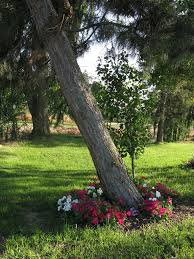Most people would like to see the trees in their yard grow straight and mighty as it should, but sometimes that isn’t the case and the tree has it’s own intentions. Rain, snow, storms and high winds are all factors that can be detrimental to trees in your yard, and of course the malleable young trees with their supple trunks and branches are by far the most at risk. You wake up one morning after a brutal storm, coffee in hand and there it is, mother natures handy work
Is it possible to re-adjust a newly leaning tree?
ow about one that began growing bent in the first place? More often than not, you can remedy most trees that have taken a bent path, if the tree is juvenile enough and if you know what it is you are doing.
It is a common belief amongst arborists that a tree will grow best without the use of a stake, however there are situations where a stake is necessary to correct a tree from leaning.
Saplings for example have a very small root ball and have a hard time supporting their growth on their own. Saplings planted on gusty sites and thinly stemmed trees that have difficulty supporting their own weight are all runner ups for staking
Stakes are used to temporarily support a tree so that it’s root system can establish enough to eventually support itself. When staking, leave the stake in place for a growing season, they should be made with metal or sturdy wood and shouldn’t exceed 5′. Large trees may need more than one stake and guy rope whereas young trees only need one stake and guy rope.
To straighten a tree, drive the stake next to the planting hole and upwind of the tree. Bind the stake and tree trunk with a guy rope or wire but never around the trunk. You should use a flexible material such as rubber or cloth as the young tree has fragile bark and can damage itself as it grows on the wire or rope. Tighten the rope gradually to bring the tree to an upright position.
.


